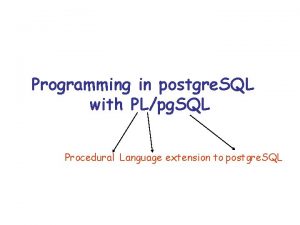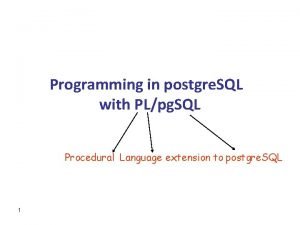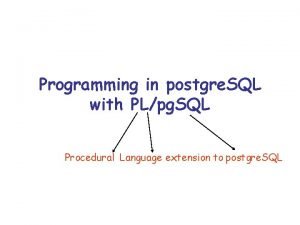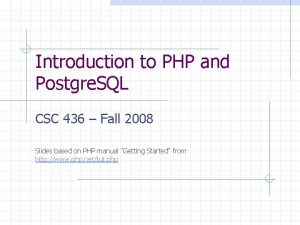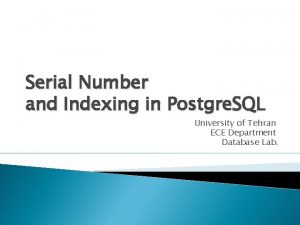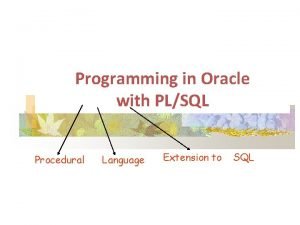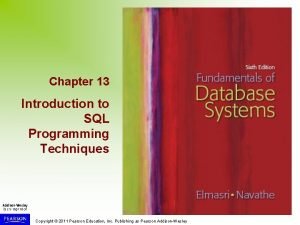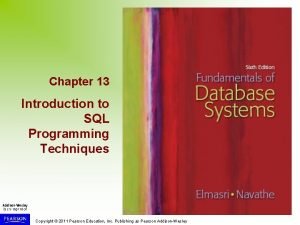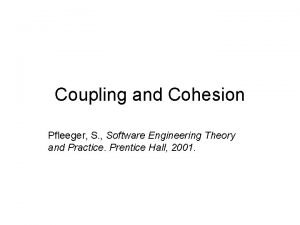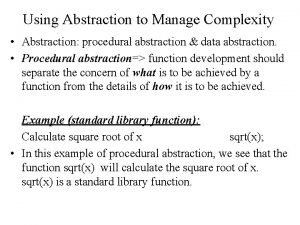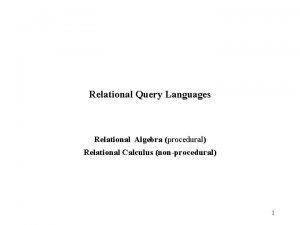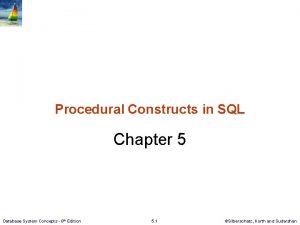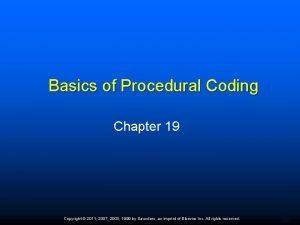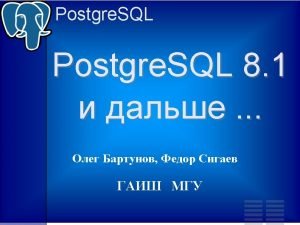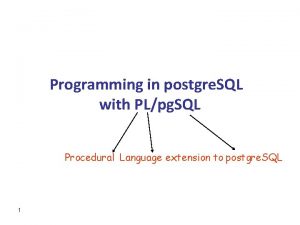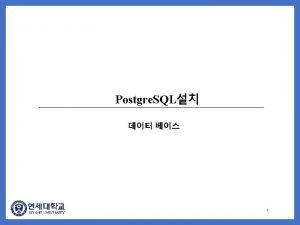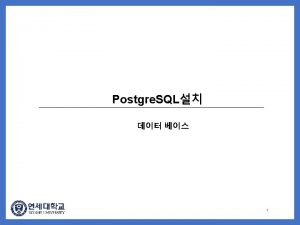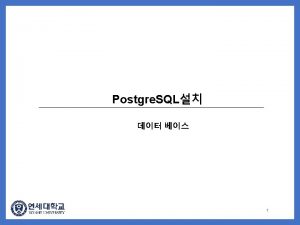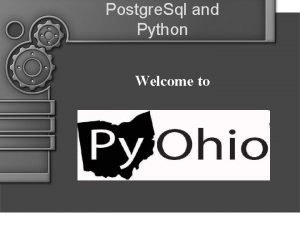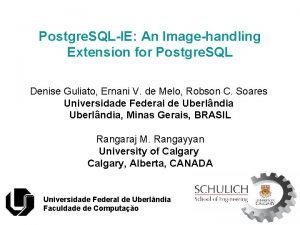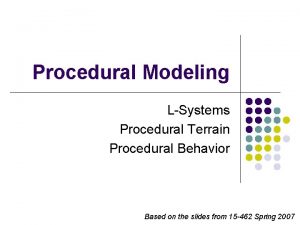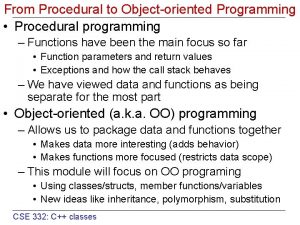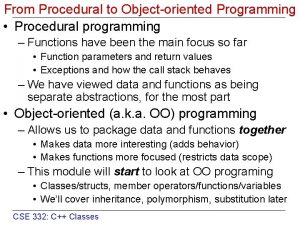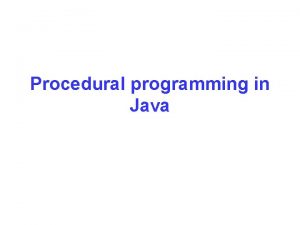Programming in postgre SQL with PLpg SQL Procedural




![Creating a function: Create [or replace] function func. Name(var. Name 1 var. Type 1, Creating a function: Create [or replace] function func. Name(var. Name 1 var. Type 1,](https://slidetodoc.com/presentation_image_h2/4ae711a1af2da5a2a100131dd9df0f4e/image-5.jpg)





















![For loop FOR var IN [ REVERSE ] st. Range. . end. Range LOOP For loop FOR var IN [ REVERSE ] st. Range. . end. Range LOOP](https://slidetodoc.com/presentation_image_h2/4ae711a1af2da5a2a100131dd9df0f4e/image-27.jpg)


















- Slides: 45

Programming in postgre. SQL with PL/pg. SQL Procedural Language extension to postgre. SQL

Why a Programming Language? • Some calculations cannot be made within a query (examples? ) • Two options: – Write a program within the database to calculate the solution – Write a program that communicates with the database and calculates the solution • Both options are useful, depending on the circumstances. – Option 1 reduces the communication need, and can be faster!

PL/pg. SQL • Specific for Postgres (similar languages available for other db systems) • Allows using general programming tools with SQL, for example: loops, conditions, functions, etc. • This allows a lot more freedom than general SQL • We write PL/pg. SQL code in a regular file, for example first. Pl. sql, and load it with i in the psql console. • Documentation available at: http: //www. postgresql. org/docs/8. 1/static/plpgsql. ht ml#PLPGSQL-OVERVIEW

PL/pg. SQL Blocks PL/pg. SQL code is built of Blocks, with a unique structure: DECLARE (optional) /* All Variables Declared Here*/ BEGIN (mandatory) /* Executable statements (what the block DOES!)*/ EXCEPTION (optional) /* Exception handling*/ END; (mandatory)
![Creating a function Create or replace function func Namevar Name 1 var Type 1 Creating a function: Create [or replace] function func. Name(var. Name 1 var. Type 1,](https://slidetodoc.com/presentation_image_h2/4ae711a1af2da5a2a100131dd9df0f4e/image-5.jpg)
Creating a function: Create [or replace] function func. Name(var. Name 1 var. Type 1, var. Name 2 var. Type 2, …) returns return. Var. Type AS $$ And at the end of the function: $$ language plpgsql; Create or replace function my. Multiplication(var 1 integer, var 2 integer) returns integer as $$ BEGIN return var 1*var 2; END; $$ language plpgsql

The $$ Signs • The body of the function is actually a string, from the standpoint of the db • We can use quotes to create this string, or use dollar string encoding – Easier if there are string literals in the program Create or replace function my. Multiplication(var 1 integer, var 2 integer) returns integer as $$ BEGIN return var 1*var 2; END; $$ language plpgsql

The Return Value • If the function returns a single parameter, you can use the return syntax below • Must use a return statement to return the value Create or replace function my. Multiplication(var 1 integer, var 2 integer) returns integer as $$ BEGIN return var 1*var 2; END; $$ language plpgsql • Functions can also return several values, see next slide…

Alternatively, the return value and type can be declared as function parameters: Create [or replace] function func. Name(var. Name 1 var. Type 1, var. Name 2 var. Type 2, …, out ret. Var. Name retvar. Type) AS $$ Example: (Note that there is no explicit call to return!) Create or replace function my. Addition(var 1 integer, var 2 integer, out add. Res integer) as $$ BEGIN add. Res: =var 1+var 2; END; $$ language plpgsql

Another Example: Multiple Return Values Create or replace function sum_and_product(x integer, y integer, out sum integer, out prod integer) as $$ BEGIN sum: =x+y; prod: =x*y; END; $$ language plpgsql

first. sql: Calling Functions Create or replace function add. Tax(price real, OUT res 1 real) as $$ begin res 1: = price*1. 155; end; $$language plpgsql; In the psql console write: i first. sql Then you can call the function using, e. g. , : Insert into prices. Table values(add. Tax(20)); Select (add. Tax(price)) from catalog; Perform add. Tax(20);

Defining Variables: Declare • Variables must be defined in the declare section. • The general syntax of a variable declaration is: name [CONSTANT] type [ NOT NULL] [{DEFAULT | : = } expression] Examples: user_id integer; name CONSTANT integer : = 10; name CONSTANT integer DEFAULT 10; url varchar NOT NULL : = ‘http: //www. abc. com’;

Declaring Variables with the %TYPE Attribute Examples DECLARE sname fav_boat my_fav_boat Sailors. sname%TYPE; VARCHAR(30); fav_boat%TYPE : = 'Pinta';

Declaring Variables with the %ROWTYPE Attribute Declare a variable with the type of a ROW of a table. reserves_record Accessing table Reserves%ROWTYPE; And how do we access the fields in reserves_record? reserves_record. sid : = 9; Reserver_record. bid : = 877;

Select into Create or replace function my. Sp(var 1 integer) returns integer as $$ DECLARE sp_var sportsman%rowtype; BEGIN select * into sp_var from sportsman; return sp_var. age*var 1; END; $$language plpgsql • If select returns more than one result, the first row will be put into sp_var • If no rows were returned, nulls will be put in sp_var • Notice that unless ‘Order by’ was specified, the first row is not well defined

Select into strict Create or replace function my. Sp(var 1 integer) returns integer as $$ DECLARE sp_var sportsman%rowtype; BEGIN select * into strict sp_var from sportsman; return sp_var. age*var 1; END; $$language plpgsql • In this case, if more or less than one row is returned, a run-time error will occur

Record A record is similar to row-type, but we don’t have to predefine its structure DECLARE var. Record record; BEGIN select * into var. Record from sailors where sid = 117; END;

Checking if a row was returned Declare my. Var sportsman%rowtype; Begin Select * into my. Var from sportsman where age=4; If not found then…

Conditioning IF boolean-expression THEN statements END IF; … IF v_age > 22 THEN UPDATE sportsman SET salary = salary+1000 WHERE sid = v_sid; END IF; … Assume variables in blue were defined above the code fragment

More Conditioning IF boolean-expression THEN statements ELSE statements END IF; IF boolean-expression THEN statements ELSIF boolean-expression THEN statements … ELSE statements END IF ;

Example CREATE or replace FUNCTION assess. Rate(rating real) RETURNS text AS $$ BEGIN if rating>9 then return 'great'; elsif rating>7 then return 'good'; elsif rating>5 then return 'keep on working'; elsif rating>3 then return 'work harder!'; else return 'you can stop working'; end if; END; $$ LANGUAGE plpgsql; Select assess. Rate(6. 7);

Suppose we have the following table: create table mylog( who text, num_run integer ); • Write a function that when called by a user: – if user is already in table, increment num_run. – Otherwise, insert user into table mylog who num_run Peter 3 John 4 Moshe 2

CREATE FUNCTION update. Logged() RETURNS void AS $$ DECLARE cnt integer; BEGIN Select count(*) into cnt from mylog where who=user; If cnt>0 then update mylog set num_run = num_run + 1 where who = user; else insert into mylog values(user, 1); end if; end; $$ LANGUAGE plpgsql;

Simple loop LOOP statements END LOOP; • Terminated by Exit or return • Exit: only causes termination of the loop • Can be specified with a condition: Exit when …

LOOP -- some computations IF count > 0 THEN EXIT; END IF; END LOOP; LOOP -- some computations EXIT WHEN count > 0; END LOOP; Examples

Continue • The next iteration of the loop is begun Create or replace function my. Test(var 1 integer) returns integer as $$ DECLARE i integer; BEGIN i: =1 loop exit when i>var 1 i=i+1 continue when i<20 raise notice 'num is %', i end loop return i*var 1 END $$language plpgsql What does this print for my. Test(30)?

While loop WHILE expression LOOP --statements END LOOP ; WHILE money_amount > 0 AND happiness<9 LOOP -- buy more END LOOP;
![For loop FOR var IN REVERSE st Range end Range LOOP For loop FOR var IN [ REVERSE ] st. Range. . end. Range LOOP](https://slidetodoc.com/presentation_image_h2/4ae711a1af2da5a2a100131dd9df0f4e/image-27.jpg)
For loop FOR var IN [ REVERSE ] st. Range. . end. Range LOOP statements END LOOP; FOR i IN 1. . 10 LOOP RAISE NOTICE 'i is %', i; END LOOP; The variable var is not declared in the declare section for this type of loop. FOR i IN REVERSE 10. . 1 LOOP -- some computations here END LOOP;

Looping Through Query Results FOR target IN query LOOP statements END LOOP; CREATE or replace FUNCTION assess. Rates() RETURNS void AS $$ DECLARE i record; BEGIN For i in select rating from ratings order by rating loop if i. rating>9 then raise notice 'great'; elsif i. rating>7 then raise notice 'good'; elsif i. rating>5 then raise notice 'keep on working'; elsif i. rating>3 then raise notice 'work harder!'; else raise notice 'you can stop working'; end if; end loop; END; $$ LANGUAGE plpgsql;

Trapping exceptions DECLARE declarations BEGIN statements EXCEPTION WHEN condition [ OR condition. . . ] THEN handler_statements. . . END; See http: //www. postgresql. org/docs/8. 1/static/ errcodes-appendix. html for a list of all exceptions

Create or replace function errors(val integer) returns real as $$ Declare val 2 real; BEGIN val 2: =val/(val-1); return val 2; Exception when division_by_zero then raise notice 'caught a zero division'; return val 2; End; $$ LANGUAGE plpgsql;

Triggers

Triggers • A trigger defines an action we want to take place whenever some event has occurred. • When defining a trigger, you have to define: Triggering Event When Level INSERT/UPDATE/ DELETE BEFORE/AFTER ROW/STATEMENT

Triggers • The trigger function can be written in PL/pg. SQL • The function must return type trigger • First we create a trigger function and then create the trigger using create trigger • Row-level triggers are called one time for each row modified by a statement – therefore many be called many times due to a single statement • Statement-level triggers are called one time for a statement, regardless of how many rows are changed • Pay attention to recursive trigger firing

Create trigger CREATE TRIGGER name { BEFORE | AFTER } { event [ OR. . . ] } ON table [ FOR EACH ROW |STATEMENT ] EXECUTE PROCEDURE funcname ( arguments ) CREATE TRIGGER emp_trig BEFORE INSERT OR UPDATE ON employee FOR EACH ROW EXECUTE PROCEDURE emp_trig_func ();

Writing a trigger function When a trigger is fired, several variables are automatically created: • New (available only for row level triggers) • Old (available only for row level triggers) • TG_OP (name of the operation which caused the trigger) • …

Important! Row Level Triggers, BEFORE • A return value of null signals to the trigger manager to skip the rest of the operation for this row – subsequent triggers are not fired – the INSERT/UPDATE/DELETE does not occur for this row. • A return value that is non-null causes the operation to proceed with that row value. – Returning a row value different from the original value of NEW alters the row that will be inserted or updated (but has no direct effect in the DELETE case).

Important! All Other Types of Triggers • The return value of a BEFORE or AFTER statement-level trigger or an AFTER row-level trigger is always ignored; – it may as well be null. • However, any of these types of triggers can still abort the entire operation by raising an error.

CREATE FUNCTION to. Upper() RETURNS trigger AS $$ BEGIN new. sname : = UPPER(new. sname); return new; END; $$ LANGUAGE plpgsql; CREATE TRIGGER to. Upper. Trig BEFORE INSERT or UPDATE on Sailors FOR EACH ROW execute procedure to. Upper();

Another Example CREATE TABLE emp ( empname text, salary integer, last_date timestamp, last_user text );

CREATE FUNCTION emp_stamp() RETURNS trigger AS $$ BEGIN -- Check that empname and salary are given IF NEW. empname IS NULL THEN RAISE EXCEPTION 'empname cannot be null'; END IF; IF NEW. salary IS NULL THEN RAISE EXCEPTION '% cannot have null salary', NEW. empname; END IF; IF NEW. salary < 0 THEN RAISE EXCEPTION '% cannot have a negative salary', NEW. empname; END IF; NEW. last_date : = current_timestamp; NEW. last_user : = current_user; RETURN NEW; END; $$ LANGUAGE plpgsql; CREATE TRIGGER emp_stamp BEFORE INSERT OR UPDATE ON emp FOR EACH ROW EXECUTE PROCEDURE emp_stamp ();

CREATE TABLE emp ( empname text NOT NULL, salary integer ); CREATE TABLE emp_backup( operation char(1) NOT NULL, stamp timestamp NOT NULL, userid text NOT NULL, empname text NOT NULL, salary integer );

CREATE OR REPLACE FUNCTION process_emp_backup() RETURNS TRIGGER AS $$ BEGIN IF (TG_OP = 'DELETE') THEN INSERT INTO emp_backup SELECT 'D', current_timestamp, current_user, OLD. *; RETURN null; ELSIF (TG_OP = 'UPDATE') THEN INSERT INTO emp_backup SELECT 'U', current_timestamp, current_user, NEW. *; RETURN null; ELSIF (TG_OP = 'INSERT') THEN INSERT INTO emp_backup SELECT 'I', current_timestamp, current_user, NEW. *; RETURN null; END IF; RETURN NULL; END; $$ LANGUAGE plpgsql;

CREATE TRIGGER emp_backup AFTER INSERT OR UPDATE OR DELETE ON emp FOR EACH ROW EXECUTE PROCEDURE process_emp_backup ();


Statement Trigger CREATE FUNCTION shabbat_trig_func() RETURNS trigger AS $$ BEGIN if (TO_CHAR(current_date, 'DY')='SAT') then raise exception ‘no work on shabbat!’; end if; Return null; END; $$ LANGUAGE plpgsql; CREATE TRIGGER no_work_on_shabbat_trig BEFORE INSERT or DELETE or UPDATE on sailors for each statement execute procedure shabbat_trig_func();
 Plpg sql
Plpg sql Plpg sql
Plpg sql Plpg sql
Plpg sql Postgre
Postgre Postgre
Postgre Postgre serial
Postgre serial Post gre sql
Post gre sql Procedural programming python
Procedural programming python Procedural programming languages
Procedural programming languages What is procedural programming
What is procedural programming Sql procedural
Sql procedural Oracle procedural language extensions to sql
Oracle procedural language extensions to sql What is system program
What is system program Programing adalah
Programing adalah Perbedaan linear programming dan integer programming
Perbedaan linear programming dan integer programming Greedy algorithm vs dynamic programming
Greedy algorithm vs dynamic programming Linear vs integer programming
Linear vs integer programming Introduction to sql programming techniques
Introduction to sql programming techniques Introduction to sql programming techniques
Introduction to sql programming techniques Difference between pl sql and mysql
Difference between pl sql and mysql Pl/sql unit testing
Pl/sql unit testing Procedural abstraction in c++
Procedural abstraction in c++ Due process definition law
Due process definition law Procedural rigour
Procedural rigour Procedure writing topics
Procedure writing topics Rrhagia a suffix denoting excessive flow, bleeding
Rrhagia a suffix denoting excessive flow, bleeding Blender procedural road
Blender procedural road Module cohesion
Module cohesion Procedural knowledge examples in math
Procedural knowledge examples in math Procedural self
Procedural self Substantive vs procedural due process
Substantive vs procedural due process Classroom management dimensions
Classroom management dimensions Functional cohesion example
Functional cohesion example Procedural abstraction
Procedural abstraction Relational calculus is a procedural language
Relational calculus is a procedural language Procedural constructs
Procedural constructs Public health dentistry definition
Public health dentistry definition Cpt symbols and meanings
Cpt symbols and meanings Features of a procedural text
Features of a procedural text Procedural knowledge in ai
Procedural knowledge in ai 2d procedural animation
2d procedural animation Verilog pli
Verilog pli Logical cohesion example
Logical cohesion example Pluralist democracy
Pluralist democracy The six sections of the cpt manual include
The six sections of the cpt manual include Hrinfo dadeschools net dpgt
Hrinfo dadeschools net dpgt
